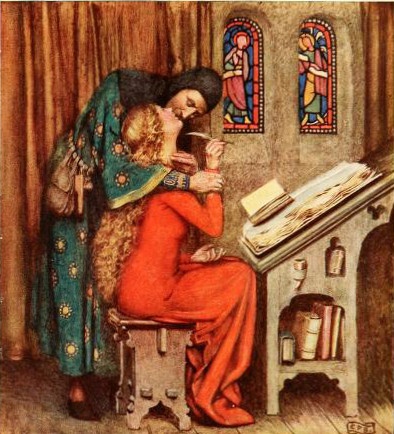
A 20th century illustration of Heloise and Abelard, by Eleanor Fortescue Brickdale, shows them stealing a kiss. Wikimedia Commons.
Heloise (c. 1098 – 1163 CE) was a French scholar and abbess, who is famous for the love letters she wrote to her husband, Peter Abelard, from a religious convent.
Heloise’s birthdate and parents are a mystery to us. We know that she spent her childhood at a convent near Paris; she might have been an illegitimate child who was given to the church to raise. She was a bright student who became fluent in Latin, Greek, and Hebrew, and trained in grammar and rhetoric (considered important parts of classical philosophy). She eventually moved to Paris to live with her uncle Fulbert, who was the canon of Notre Dame Cathedral.
In Paris, a fiery young philosopher and teacher named Peter Abelard saw the teenage Heloise and fell in love with her, attracted by her intelligence. He convinced Fulbert to let him move in and become her tutor. Heloise and Abelard were intellectual equals, and they were soon passionately in love: Abelard later wrote that their study sessions became excuses for kissing instead of teaching! They began to write love letters and poems to one another, which survive as scraps and fragments.
Eventually, Heloise became pregnant and her uncle, furious with Abelard, put an end to their relationship. She snuck out of Paris disguised as a nun and gave birth to their son Astralabe outside the city. Heloise left the baby with Abelard’s family and came back to the city. When Abelard asked her to marry him, she refused at first, concerned that his career would suffer. But her uncle and Abelard both insisted, and they were secretly married. However, Heloise was out of favour with her uncle, and she fled back to the convent at Argenteuil, where she had lived as a child. As revenge for dishonouring his family, Fulbert sent men to break into Abelard’s bedroom and attack him. Both of the lovers moved into religious convents and lost touch with each other: they didn;t communicate for another twelve years. They both became well-respected leaders in their communities.
Heloise spoke out against marriage, which she saw as taking away people’s freedom; she argued that women who married for money (which was common at the time) were essentially selling themselves. This was a radically feminist argument for the 12th century! In the convent, Heloise found that she wasn’t restricted by the demands of a husband or children, but was free to devote her time to thinking, writing, and prayer.
When Heloise learned that Abelard had published his account of their story, she wrote to him and confessed that she still loved him deeply. Abelard claimed that he no longer loved her, but answered her letters anyway, advising her on spiritual matters and answering her questions about the Bible. Abelard clearly still respected Heloise as an intellectual equal, as he quoted her thoughts in some of his work. The couple wrote to each other for the next few years, until Abelard died in 1142. Heloise continued to lead her community as abbess until she died.
The story of Heloise and Abelard is one of the most famous love stories in history, and their love letters are still read today. Educated, independent and passionate, Heloise was a woman ahead of her time: she wasn’t afraid to argue with Abelard about what was best for her. They are said to be buried together at Pere-Lachaise Cemetery.
